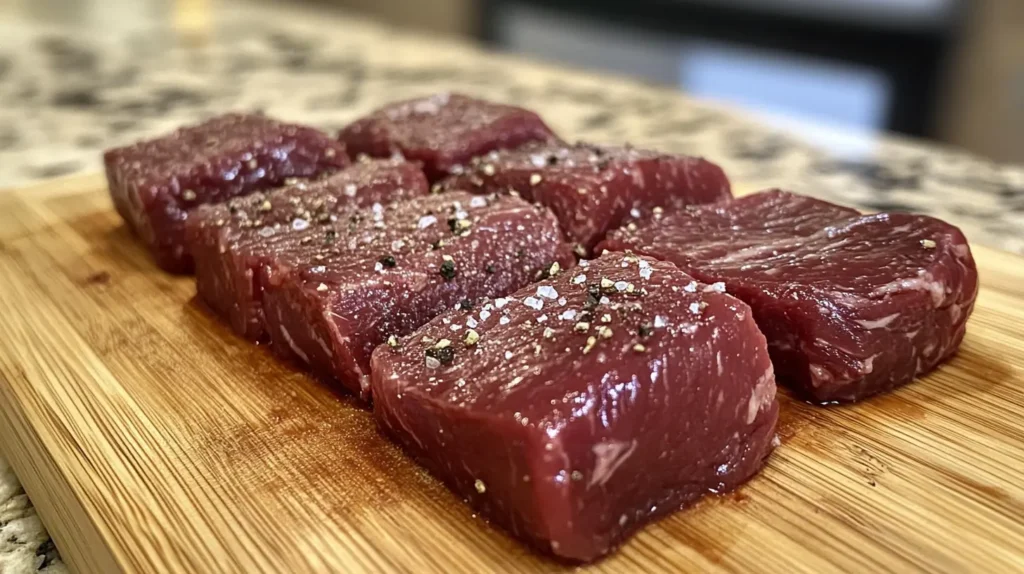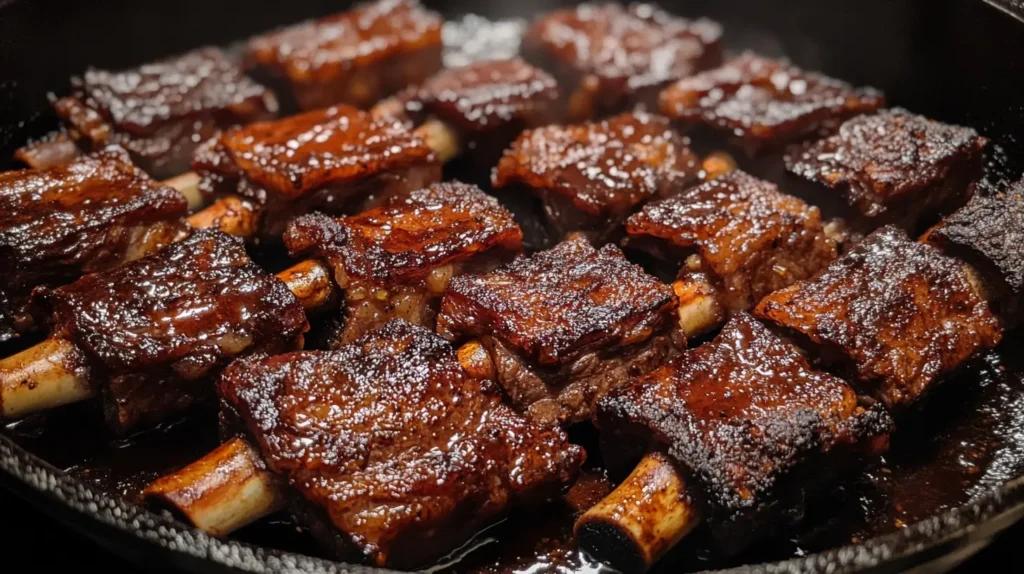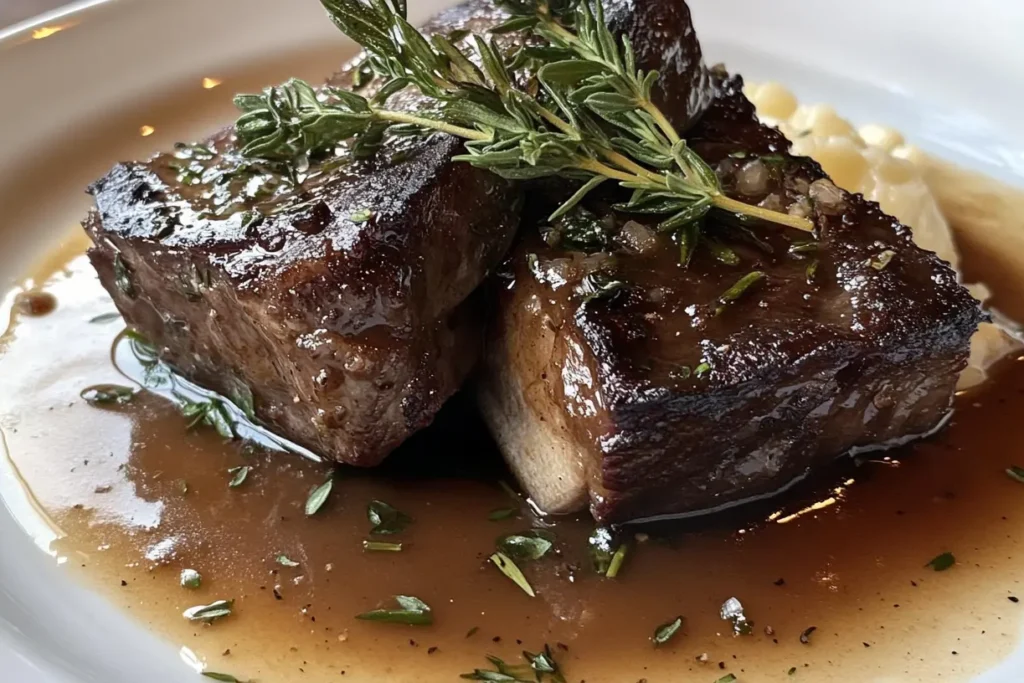Table of contents
Understanding the Basics of Beef Short Ribs
What Makes Beef Short Ribs Tough?
Beef short ribs are a flavorful but challenging cut of meat. Their toughness comes from the high concentration of connective tissue, including collagen, within the meat. While this tissue can create tender and juicy results when cooked properly, it can also lead to tough and chewy meat if not handled correctly. Understanding the structure of short ribs is essential to avoid these issues.
The primary reason short ribs turn out tough is that the collagen and connective tissue need time and low heat to break down. When cooked too quickly or at too high a temperature, these tissues remain intact, resulting in a rubbery texture. To make short ribs tender, you need to use slow cooking methods that allow the collagen to melt into gelatin. This transformation is what gives the meat its rich and succulent quality.
Additionally, the cooking process should include a moist environment. Dry heat methods, like grilling without a marinade, can lead to drying out the meat rather than tenderizing it. Ensuring proper cooking techniques can make all the difference in the final texture of the ribs.
Common Mistakes in Cooking Beef Short Ribs
Many home cooks make mistakes when preparing short ribs, leading to less-than-desirable results. One of the most common errors is treating short ribs like other cuts of beef, such as steak. Unlike steak, which benefits from quick, high-heat cooking, short ribs require a low and slow approach to unlock their full potential.
Another frequent mistake is not seasoning the ribs adequately. Seasoning is not just about flavor but also plays a role in tenderizing the meat. Skipping this step can result in bland ribs that lack depth. Similarly, some people skip the browning step, thinking it’s unnecessary. Browning adds a layer of caramelized flavor and helps lock in the juices, setting the foundation for a successful dish.
Lastly, rushing the cooking process is a major pitfall. Cooking short ribs at high heat or for a short time can prevent the connective tissues from breaking down.
This results in meat that is tough and difficult to eat. Patience is key when working with this cut of meat.
Choosing the Right Cut of Beef Short Ribs

The type of short ribs you choose also significantly affects the cooking process and final texture. There are two main types: English cut and Flanken cut. English cut ribs are larger, with one bone per piece, and have more meat. This cut is ideal for slow cooking methods, such as braising or using a slow cooker. The thick meat on the English cut benefits from prolonged exposure to heat and liquid.
Flanken cut, on the other hand, is thinner and includes cross-sections of bones. It’s often used in grilling or quick-cooking recipes, like Korean-style short ribs. This cut benefits from marination and shorter cooking times, making it versatile for dishes that don’t require hours of preparation.
For a detailed comparison of the two cuts and how to use them, you can explore this guide. Understanding the strengths of each cut helps you choose the right one for your recipe.
How Fat Content Impacts Tenderness
Fat content is another critical factor in determining the tenderness of short ribs. Well-marbled ribs are more likely to turn out tender and juicy because the fat melts during cooking, adding flavor and moisture. The melting fat also helps keep the meat from drying out, which is especially important during long cooking processes.
However, too much fat can lead to a greasy dish, while too little fat may result in dryness. A balanced cut with good marbling ensures the best results. When selecting short ribs, look for cuts with a visible distribution of fat within the meat, as these will provide the most flavorful and tender results.
By understanding the importance of cut type, fat content, and proper preparation, you can set yourself up for success. Mastering these basics is the first step to ensuring your beef short ribs are never tough again.
Techniques to Achieve Tender Short Ribs

Preparing Beef Short Ribs for Cooking
Preparing short ribs correctly before cooking is essential to achieving tender results. The process starts with seasoning. Generously seasoning the ribs with salt and pepper, or using a spice rub, helps enhance their natural flavors. Letting the seasoning sit for at least 30 minutes before cooking allows the flavors to penetrate the meat.
Another critical step is patting the ribs dry with a paper towel before seasoning or cooking. This removes excess moisture from the surface, which ensures a better sear when browning the meat. Proper browning is key to locking in juices and building flavor, as it creates a caramelized crust that adds depth to the dish.
It’s also important to trim any excessive fat from the ribs. While some fat is beneficial for moisture and flavor, too much can result in a greasy dish. Balancing the fat content ensures the best results and a pleasant texture in the finished product.
Pre-Browning for Flavor Development
Browning the short ribs before slow cooking or braising is a step you should never skip. This process enhances the flavor by creating a savory crust on the meat. To achieve this, heat a small amount of oil in a heavy-bottomed skillet or Dutch oven over medium-high heat. Once the oil is hot, sear the ribs on all sides until they are golden brown.
Browning does more than improve flavor—it also creates a foundation for a rich and robust sauce. The browned bits left in the pan, known as fond, are full of flavor and can be deglazed with liquid to form the base of the braising liquid or sauce. These bits contribute to the overall complexity of the dish.
While browning may take a little extra time, it’s a worthwhile investment that pays off in the final dish. Skipping this step can result in meat that lacks depth and complexity of flavor, so make sure to brown your short ribs before moving on to the next step.
Braising as the Go-To Method
Braising is the most popular and reliable method for cooking short ribs to tender perfection. This technique involves cooking the meat slowly in a flavorful liquid, allowing the connective tissues to break down over time. The result is meat that is so tender it falls off the bone and is infused with the rich flavors of the braising liquid.
To start, after browning the ribs, remove them from the pan and add aromatics like onions, garlic, carrots, and celery. Sauté the aromatics until they are softened, then deglaze the pan with your liquid of choice. Options include beef broth, red wine, or a combination of both. These liquids not only add flavor but also provide the moisture necessary for the braising process.
Once the liquid has been added, return the ribs to the pan, making sure they are partially submerged. Cover the pan with a tight-fitting lid and place it in a preheated oven at 300°F (150°C). Allow the ribs to cook for 2.5 to 3 hours, checking occasionally to ensure the liquid level remains adequate. The low, slow heat helps the collagen in the ribs dissolve into gelatin, resulting in a silky, tender texture.
Why Braising Works
Braising works so well because it combines moist heat and a controlled cooking environment. The liquid keeps the ribs from drying out, while the steady heat gently transforms the tough connective tissue into gelatin. This process not only makes the meat tender but also enriches the overall flavor of the dish.
For best results, always use a heavy pot or Dutch oven with a tight-fitting lid to trap the steam. The sealed environment prevents moisture from escaping and ensures even cooking. Braising is a time-tested method that guarantees tender, flavorful short ribs.
Step-by-Step Guide to Braising Short Ribs
Here’s a simple guide to braising short ribs:
- Preheat your oven to 300°F (150°C).
- Brown the ribs on all sides in a Dutch oven, then remove them from the pot.
- Add aromatics and sauté until softened.
- Deglaze the pan with broth, wine, or another flavorful liquid.
- Return the ribs to the pot, partially submerged in the liquid.
- Cover the pot and place it in the oven. Cook for 2.5 to 3 hours.
- Check occasionally to ensure there’s enough liquid in the pot.
For a more detailed guide, visit this step-by-step recipe. Following these steps ensures your short ribs turn out perfectly every time.
Alternative Cooking Methods for Tender Short Ribs

Slow Cooking: A Set-It-and-Forget-It Method
Slow cooking is one of the easiest and most reliable methods for tenderizing beef short ribs. This approach involves cooking the ribs at a low temperature over an extended period, allowing the meat to become soft and flavorful with minimal effort. It’s perfect for those who want a convenient, hands-off method.
To begin, season and brown the short ribs just as you would for braising. Browning helps build flavor and ensures the ribs develop a rich color. Once browned, transfer the ribs to a slow cooker. Add aromatics like onions, garlic, carrots, and herbs for extra depth. Pour in your liquid of choice, such as beef broth, red wine, or a combination of both, ensuring the ribs are partially submerged.
Set the slow cooker to low and cook for 6 to 8 hours. The prolonged cooking time ensures the connective tissues break down completely, resulting in fork-tender meat. This method is ideal for busy schedules, as it requires very little attention once the slow cooker is set. While slow cooking doesn’t always develop the same depth of flavor as braising, it is a foolproof way to achieve tender short ribs.
For more detailed instructions on slow-cooking short ribs, check out this guide. It offers step-by-step tips to make sure your ribs turn out perfectly every time.
Best Liquid Choices for Tender Results
The liquid you choose for slow cooking or braising short ribs plays a crucial role in the final dish. Not only does it keep the meat moist during cooking, but it also infuses the ribs with flavor. Beef broth is a classic choice, providing a rich, savory base. For a more complex flavor profile, you can combine beef broth with red wine or beer. These liquids add acidity and depth, balancing the richness of the ribs.
If you prefer a sweeter taste, tomato-based liquids or apple cider can be used. These options are excellent for creating a sauce that pairs well with the meat. Adding a splash of balsamic vinegar or soy sauce can also enhance the umami flavors of the dish. Regardless of the liquid you choose, make sure it is well-seasoned with herbs, garlic, or spices to complement the ribs.
For an even richer flavor, some cooks like to use demi-glace or concentrated stock. These ingredients intensify the sauce and create a luxurious texture. Experimenting with different liquids allows you to customize the dish to your preferences while ensuring tender and flavorful results.
Oven-Roasting and Grilling Short Ribs
While braising and slow cooking are the most common methods, oven-roasting and grilling offer alternative ways to cook short ribs. Oven-roasting is a great option for those who prefer a slightly crispier texture on the outside of the meat. To roast short ribs, preheat your oven to 325°F (160°C) and place the seasoned ribs in a roasting pan. Add a small amount of liquid, such as broth or wine, to the bottom of the pan. This helps create steam and keeps the ribs moist during cooking.
Cover the pan with aluminum foil and roast for 2 to 3 hours, checking occasionally to ensure the liquid hasn’t evaporated. For a more caramelized finish, uncover the ribs during the last 30 minutes of cooking. The result is tender meat with a slightly crispy exterior that’s full of flavor.
Grilling is another option, particularly for Flanken-style short ribs. This method works best with a good marinade that tenderizes the meat and adds flavor. Marinades often include an acidic ingredient, such as vinegar or citrus juice, combined with oil and seasonings. Allow the ribs to marinate for 4 to 6 hours before grilling.
When grilling, cook the ribs over medium heat to prevent them from drying out. Flip them occasionally and baste with the marinade for added moisture. For a deeper dive into the differences between Flanken-style and boneless short ribs, visit this article.
Both oven-roasting and grilling provide unique textures and flavors that braising or slow cooking might not achieve. These methods are excellent for creating variety and elevating the presentation of your short ribs.
Enhancing the Flavor and Preventing Toughness
Resting and Reheating Short Ribs Properly
One of the most important steps in achieving tender and flavorful short ribs is letting the meat rest after cooking. Resting the ribs for 10 to 15 minutes allows the juices to redistribute evenly throughout the meat. Cutting into the ribs immediately after cooking can cause the juices to spill out, resulting in dry and less appetizing meat.
Reheating short ribs also requires care to preserve their tenderness and flavor. To reheat, place the ribs in a covered oven-safe dish with a splash of broth or sauce to keep them moist. Set the oven to a low temperature, around 300°F (150°C), and heat for 20 to 30 minutes, depending on the portion size. Avoid using high heat, as it can dry out the meat. Reheated short ribs often taste even better because the flavors have had more time to meld together.
Proper resting and reheating techniques ensure that your short ribs remain juicy and tender, even as leftovers. These steps are simple but make a significant difference in the overall eating experience.
Why Reheating Improves Flavor
Many chefs and home cooks agree that beef short ribs often taste better the next day. This is because the flavors in the sauce and meat continue to develop as they sit, creating a deeper and more harmonious flavor profile. The overnight resting process allows the collagen and fat to firm up slightly, making the ribs easier to handle while still maintaining their tenderness.
When reheating, it’s important to add a small amount of liquid, such as broth, wine, or even water, to prevent the ribs from drying out. Covering the dish with aluminum foil or a lid traps the steam, keeping the ribs moist and reheating them evenly. Reheating in the oven is preferable to using a microwave, as the slow and steady heat ensures the meat retains its original texture and flavor.
FAQs From Readers
To address common questions about making beef short ribs tender, here are some helpful answers:
Why Are My Beef Ribs Still Tough After 5 Hours?
If your ribs remain tough after several hours of cooking, it’s likely because they haven’t reached the ideal internal temperature of 190–205°F (88–96°C). At this range, the connective tissue fully breaks down, resulting in tender meat. Using a meat thermometer can help ensure the ribs are cooked to the correct temperature.
What Temperature Should I Cook Short Ribs To?
For braising, aim for an internal temperature of at least 190°F (88°C). The best oven temperature for cooking short ribs is around 300°F (150°C). This low and slow approach allows the collagen to melt without overcooking the meat, ensuring tenderness.
Can I Overcook Short Ribs?
Yes, it’s possible to overcook short ribs, especially if the liquid evaporates or the heat is too high. Overcooked ribs can become dry and stringy. To avoid this, always monitor the liquid level during cooking and stick to low, consistent temperatures.
What’s the Best Liquid for Braising Short Ribs?
The best liquid depends on the flavor profile you want. Beef broth and red wine are classic choices for a rich, savory dish. For a sweeter taste, tomato-based liquids or apple cider work well. Adding herbs, garlic, and other aromatics to the liquid enhances the overall flavor.
Incorporating More Flavor
To take your short ribs to the next level, consider adding a finishing sauce or glaze. For example, a balsamic reduction adds a tangy, sweet element that pairs beautifully with the richness of the ribs. Alternatively, chimichurri or gremolata can provide a fresh, herbaceous contrast to the hearty meat.
Experimenting with different seasonings and marinades before cooking is another way to enhance flavor. For instance, Asian-inspired marinades with soy sauce, ginger, and garlic can create a unique twist on traditional short ribs. Similarly, adding smoked paprika or chili powder to the spice rub can introduce a subtle smoky heat.
If you’re looking for inspiration on other slow-cooked dishes, check out this guide to braised chuck roast. It shares similar techniques and flavor-enhancing tips that work well for beef short ribs.
